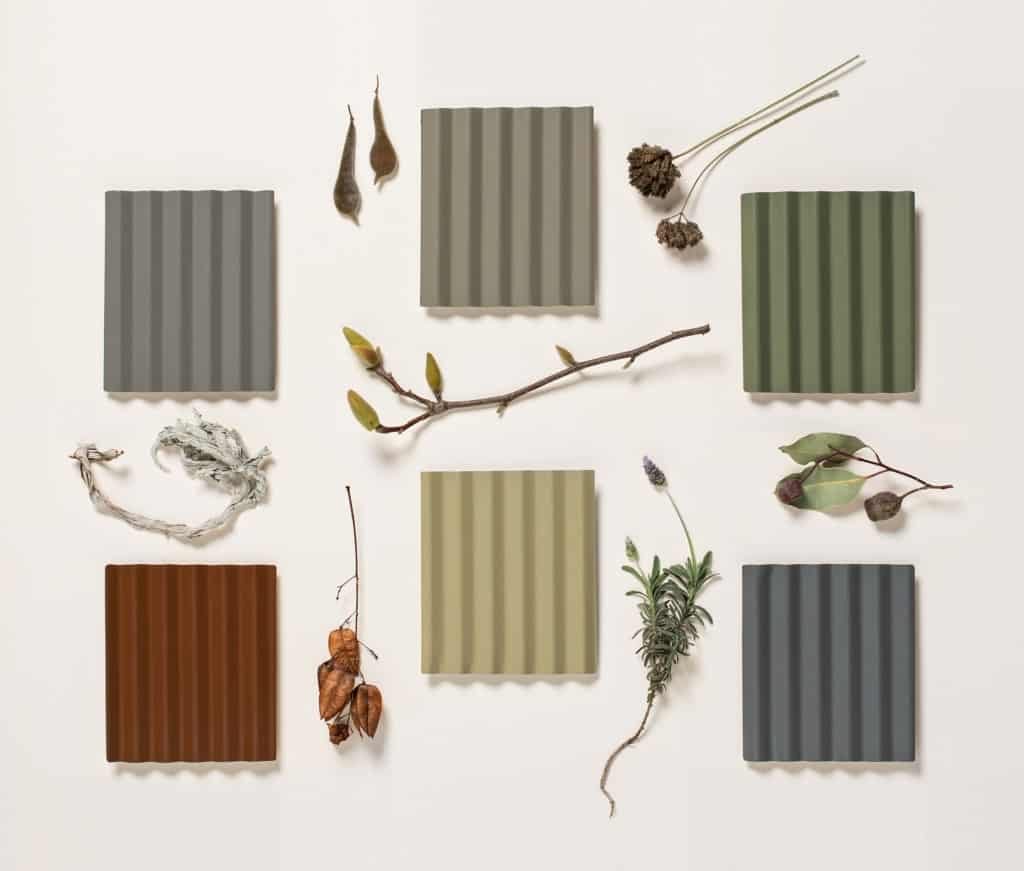When less is more
Almost 50 years after its inception, BlueScope has launched a major update of Colorbond steel – but it’s not just about the new colours. As Dimi Kyriakou discovers, there is more to this refresh than meets the eye.
Nearly half of all new homes in Australia opt for a Colorbond roof, while nine out of 10 Australian homes feature an array of products – fences, walls, gutters and fascia, water tanks, sheds, cubby houses, carports, even letterboxes – that are made from Colorbond steel.
They’re impressive stats, to say the least, so you can appreciate that any decision to tinker with the existing product line wouldn’t be made lightly.
Riding on the coattails of the launch of next generation Zincalume steel was yet another announcement from BlueScope, but this time the focus was on the colour palette of its Colorbond steel range. It has undergone its biggest change in more than 20 years, with the addition of six new colours.

The new Colorbond steel palette has introduced six colours to best accommodate the more ‘composite style’ of modern building and architecture.
Combined with the reintroduction of a popular colour, Night Sky, and the retirement of five older colours, the size of the palette has been increased to 22 – so you’re spoilt for choice, really.
Nexus Designs joint managing director and colour expert Harley Anstee says the new shades were chosen after an extensive audit of 170 architects, roll-formers, developers and project home builders.
“It was clear from industry discussions that there was a real yearning for a colour change to meet emerging trends in residential and commercial building styles,” he explains.
Before you turn the page thinking that this is just a fluff piece, give me a chance to explain the thought process behind the refresh, which has interestingly resulted in improved corrosion resistance and paint colour durability.
It’s what’s underneath that counts
As explained in the previous article, underpinning new Colorbond steel is BlueScope’s Activate technology.
The addition of magnesium to the original zinc and aluminium coating improves the galvanic action of the aluminium, so it can more actively protect the base steel.
This has its flow-on effects. Activate technology helps to make new Colorbond steel more resistant to corrosion when drilled, cut or scratched, which then goes on to improve the lifespan of the product. This works in combination with a new paint resin technology which increases the colour durability and gloss retention of all 22 colours when compared to previous-generation Colorbond steel.
“What drives that is the way the Activate technology helps corrosion performance. As you can imagine in terms of the bare product, you’ve got corrosion on the face and corrosion on the cut edges. With a painted product, the corrosion is far more focused on the edges. It contributes substantially to the performance durability,” BlueScope Research product development portfolio leader (polymer coatings) Detlev Mueller says.
“The paint changes have no impact on corrosion performance, that’s purely around gloss and colour retention. What determines the gloss holding is in the resin durability; the binder that holds the paint together. There’s a measurable difference in gloss retention between the old and new Colorbond. The change that we’re making to the paint system is working on that attribute to keep it looking newer for longer.”
The changes in Colorbond technology also work from a sustainability perspective. As many of you would be aware, depending on the roof colour, the Building Code of Australia has different requirements for the amount of insulation needed in a building.
“In 2009 we made substantial changes to the way that all of the colours across the palette reflected solar energy. Two similar colours may visually look the same, but the difference in shades mean that some take in less thermal energy and remain cooler. That was foremost in our minds when we were looking at the new colours coming into the palette,” Detlev says.
Needless to say, both Detlev and Harley had to find a happy medium between the colour choice and its ability to perform as required, both in terms of reflecting solar energy and colour durability.
“We didn’t do that as a last finesse step; if we had a particular colour in mind, our suppliers had to come up with nine to 11 shades of that colour. We worked with our suppliers and used our internal know-how to find out whether there were any benefits in changing a certain colour to a slightly different shade.”
Once a range of colours were chosen, they were put to the test.
The proof is in the pudding
Much like next generation Zincalume steel, outdoor exposure testing was required for the new colours. This started in 2008 and was backed up by laboratory analysis to accurately measure the coating performance.
After four years of exposure testing at Rockhampton in Queensland, the results were in: previous-generation Colorbond steel in the colour Surfmist had retained 76% of its original gloss, whereas the improved paint formulation for new Colorbond steel retained 85% over the period.
“We don’t just back one horse. In 2008 we had 16 different technology modifications and it was from that crop of 16 that we’ve been able to take the best step forward,” Detlev says.
“Ultimately we still rely on real-life Australian exposure; a minimum of three years before we actually make a call on systems that we’re going to use. Accelerated tests do highlight some issues and show you which horses to follow, but when you turn the product into real life applications – roofing, fascia for garages – you can start assessing the long-term performance of the product and your risk level comes down.”
Detlev adds that BlueScope has been on a continuous path of improvement to the Colorbond range since its inception and they believe the latest generation has shown the most improvement in the durability of the paint finish.
“We typically don’t throw away the technology we’ve used previously and start on something from scratch. We’re all relying on our wealth of experience in terms of durability history from all of those previous technologies. Our outdoor exposure sites and in-house analytical capability allows us to pull paints apart very early in their degradation to see what’s going on inside.
“We then feed that back to our suppliers and specify the paint systems – none of our paints that we purchase are products out of the catalogue, it’s completely custom-formulated based on our requirements.”
The benefits
BlueScope market manager (commercial and industrial) Manu Siitonen says all of this combines to make Colorbond steel better suited to Australia’s unique and demanding conditions.
“Colorbond steel is developed for, and therefore more resilient to, the intense sunlight and temperatures typical of Australian environments,” he says.
“The new paint resin technologies combined with Activate technology will enable the next generation of Colorbond steel to meet customer expectations of appearance over a longer period of time.”
The improved corrosion resistance provided by Activate technology has also allowed BlueScope to increase the warranty period for new Colorbond steel in most applications.
For instance, the warranty periods for roofing has increased from 30 years to up to 36 years; architectural roofing panels have increased from 15 years to up to 36 years; and ultra roofing has increased from 25 years to up to 36 years.
“What’s important for the building industry to understand is that changing the colour palette isn’t some artistic whim; there has been a rigorous intellectual process undertaken that dates back to 2008, for a 2013 colour palette refresh,” Manu says.
“There has been a great degree of consultation with the industry about what they want and that information has been combined with a technical process of making sure that those colours can be made in a way that meets BlueScope’s standards.
“It would be very easy to dismiss Colorbond 2013 as a few new colours, but you can see that there is so much more beneath that, literally as well as figuratively.”
The new colour palette
The new Colorbond steel palette has increased to 22 colours, with the reintroduction of the popular Night Sky, as well as the following six new colours:
Bassalt – a deep and neutral cool grey.
Wallaby – a mid-neutral cool grey with a warm tone.
Gully – a warm neutral mid-grey/green colour.
Cove – a warm mid-grey with a golden overtone.
Mangrove – a new direction in green with an olive/grey/eucalypt tone.
Terrain – a rich, earthy, red/brown inspired by inland Australia.
According to colour consultant Harley Anstee of Nexus Designs, the market was looking for a change to the Colorbond palette, which was primarily driven by recent changes to residential and commercial architectural trends. He says the new colours are trending towards more neutral tones to best accommodate the “composite style” of modern buildings.

Colour consultant Harley Anstee of Nexus Designs says the new colours are trending towards more neutral tones, primarily driven by recent changes to residential and commercial architectural trends.
“Around 10-15 years ago you had a brick colour and you had a roof colour. I think with these composite styles you’re starting to see rock, render, timber panels etc, which is driving more of a requirement for colours that will work with that more complex palette,” he says.
As part of the research process, Nexus Designs performed a colour audit which showed all respondents the new and existing colours. It ranked all the colours based on respondent feedback and then averaged the results.
“Of the 30 colours we included in the audit, all six of the new Colorbond steel colours were among the highest-rated.
“BlueScope made some bold colour choices and the survey showed they had correctly identified changing customer preferences.”
Harley predicts the new colours in the range will be adopted by allied products manufacturers, such as paint, window and garage door manufacturers.
“Colorbond is regarded as the colour leader in the Australian building products market and the six new colours BlueScope has introduced will lead the way for others in the industry to follow.”
